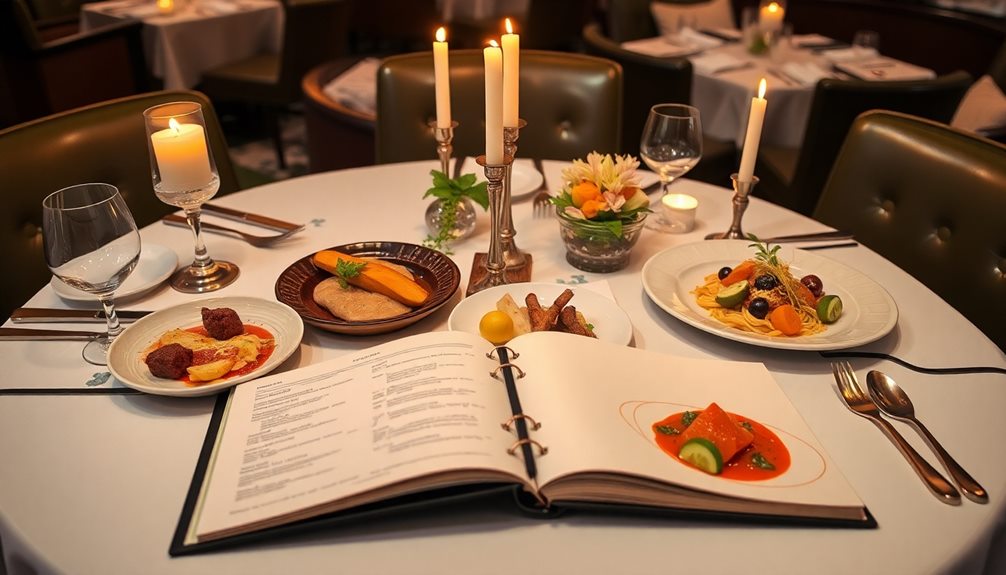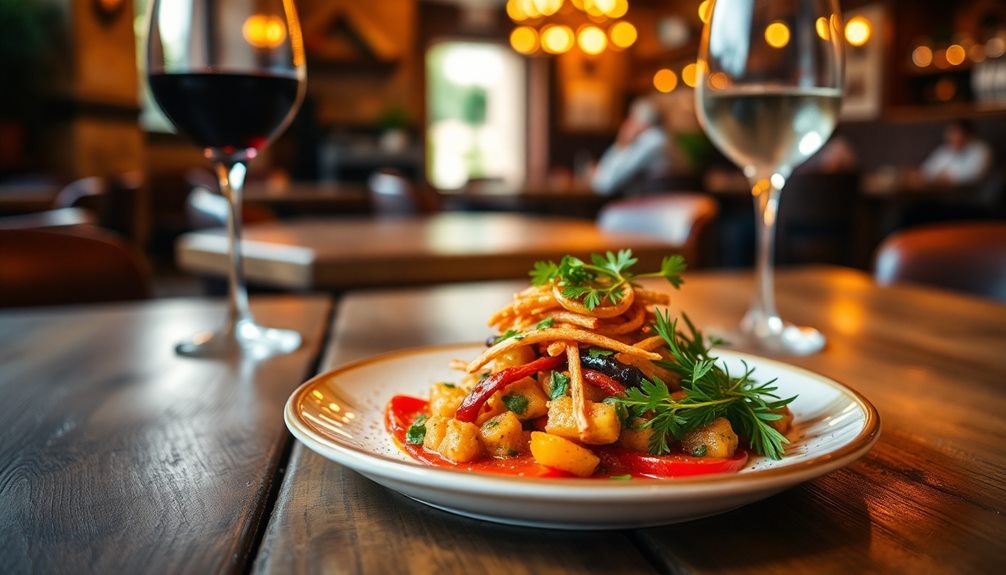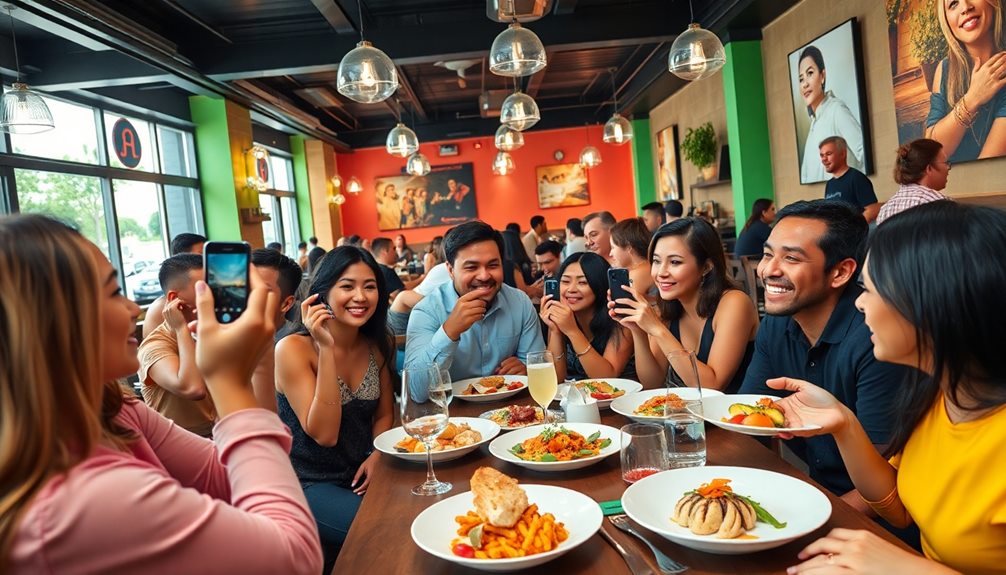To create engaging menu descriptions, use rich sensory language that appeals to taste, smell, and texture. Highlight unique aspects like locally sourced ingredients or special cooking methods. Keep your descriptions concise, making every word count because customers appreciate brevity. Incorporate descriptive adjectives like "savory," "crispy," and "zesty" to evoke desire and enhance perceived value. Understand your target audience and tailor your descriptions to their preferences. Finally, don't forget to analyze customer feedback and sales data to refine your offerings continually. If you want to discover more effective strategies, there are other insights worth exploring.
Key Takeaways
- Use rich sensory language to evoke taste, smell, and texture, enhancing the overall dining experience.
- Highlight unique ingredients and preparation methods to increase perceived value and intrigue.
- Keep descriptions concise and impactful to respect customer time while maximizing engagement.
- Incorporate storytelling elements to create emotional connections and memorable experiences for diners.
- Regularly analyze sales data and customer feedback to refine and update menu descriptions effectively.
The Significance of Menu Descriptions
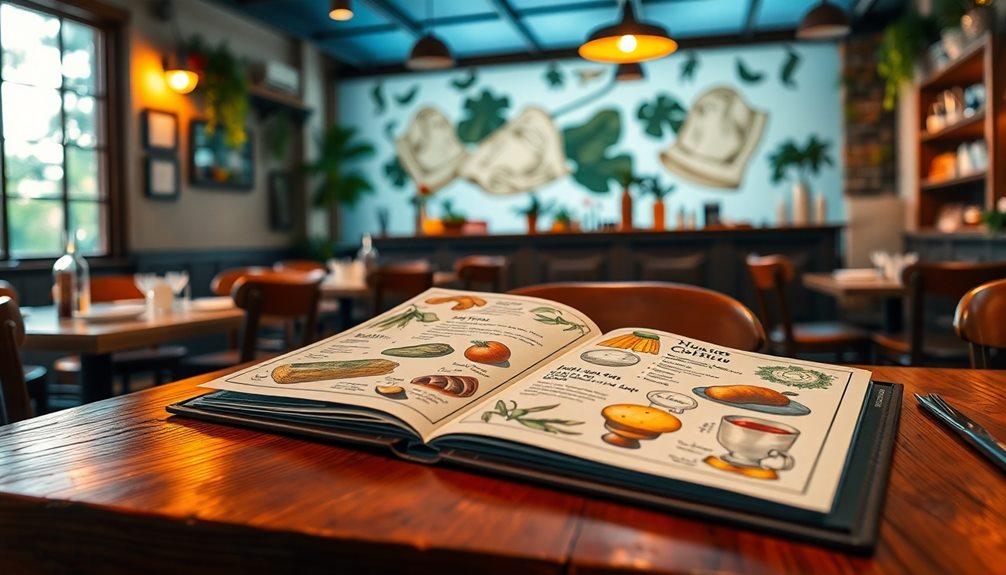
When you're dining out, the menu descriptions play a crucial role in your decision-making process. In fact, they greatly influence your customer purchasing decisions, accounting for 45% of your choices. Engaging language that evokes the taste, smell, and texture of a dish can lead to higher order values and boost customer satisfaction. Unique descriptions not only set the dishes apart from competitors but also enhance their perceived value, especially when they highlight locally sourced ingredients.
Effective menu writing is an important part of any restaurant marketing strategy. By using concise descriptions and descriptive titles, you minimize confusion during your selection process, which can lead to increased item orders per visit. This clarity encourages exploration of the menu offerings and fosters repeat business.
Ultimately, intriguing menu descriptions can increase sales considerably, contributing to the restaurant's success. By making the menu an inviting and informative tool, you make sure that every dish isn't just a meal but an experience that resonates with diners.
Key Techniques for Writing

Crafting engaging menu descriptions requires a blend of creativity and strategy. To write compelling descriptions that resonate with your customers, focus on these key techniques:
- Use rich, sensory language that appeals to taste, smell, and texture.
- Highlight unique aspects of your dishes, like locally sourced ingredients from local farms.
- Keep descriptions concise yet impactful to respect your customers' time.
Descriptive words can boost sales by up to 27%, so don't hold back on adjectives that evoke health and flavor. Emphasize key ingredients to create vivid imagery and stimulate appetite. Remember, the average time spent on a menu is only 109 seconds, so be clear and direct without overwhelming your readers.
Incorporate storytelling elements to connect emotionally with your diners. A short narrative can create a memorable experience and encourage repeat visits.
Crafting Sensory Experiences
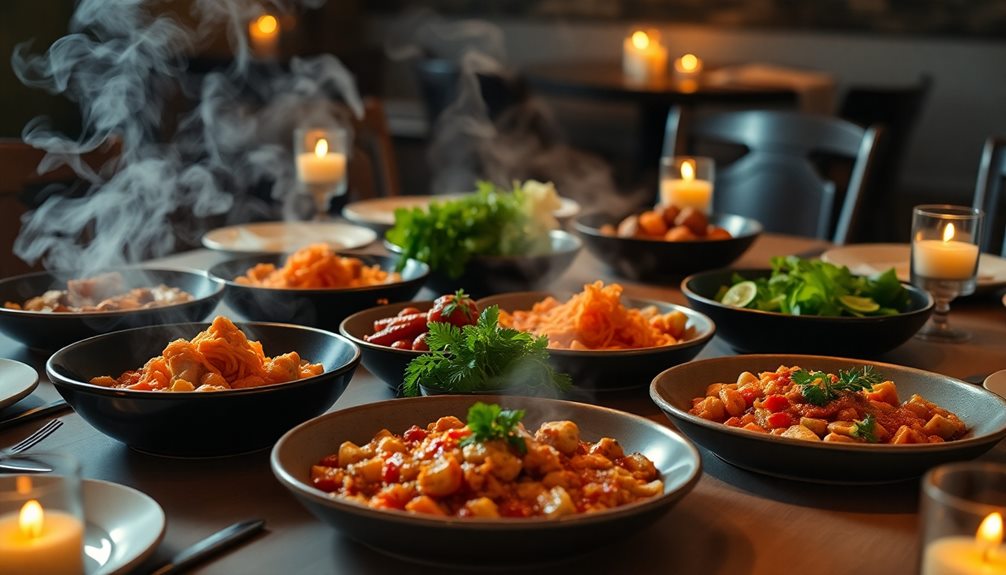
To create a memorable dining experience, you need to engage all five senses in your menu descriptions. Start by using sensory language that evokes taste and smell; words like "crispy," "savory," and "creamy" can ignite customer desire and make dishes irresistible.
For instance, consider describing a dish like the Fried Egg Quesadilla Toast with its fusion of crispy tortillas and gooey cheese, which enhances the appeal. Descriptive words not only stimulate the appetite but can also increase sales by up to 27%.
Highlighting texture and flavor, such as "tender, slow-cooked beef with a smoky finish," helps customers envision their meal, creating an engaging experience. Remember, the average diner spends only 109 seconds on a menu, so make every word count.
Incorporate storytelling elements that connect emotionally with diners. Share the origin of your ingredients or the inspiration behind a dish, forging deeper connections that make the meal memorable. This approach not only enhances the dining experience but also encourages repeat visits.
Utilize these menu writing tips to craft sensory experiences that captivate your audience, transforming simple descriptions into vivid imagery. By inviting customers to feel, taste, and smell through your menu, you'll create an atmosphere that keeps them coming back for more.
Understanding Your Target Audience

Understanding your target audience is key to creating menu descriptions that resonate and entice diners. By knowing who you're writing for, you can craft engaging menu content that speaks directly to their preferences, ultimately boosting restaurant profits. Incorporating elements that appeal to health-conscious diners, such as low carb options, can greatly enhance your menu's appeal.
To effectively connect with your diners, consider these important factors:
- Demographics: Recognize that millennials and Gen-Z diners often seek food-related content that highlights health-conscious and flavorful options.
- Dietary Preferences: Incorporate vegan, gluten-free, or other dietary options to attract a broader customer base. Many diners actively search for restaurants that cater to their specific needs.
- Customer Feedback: Analyze feedback to refine menu descriptions, ensuring they stay relevant and appealing to your target audience.
Using descriptive words that resonate with different demographics is essential. For instance, men might be drawn to hearty dishes and portion sizes, while women often focus on taste and aroma.
Enhancing Perceived Value
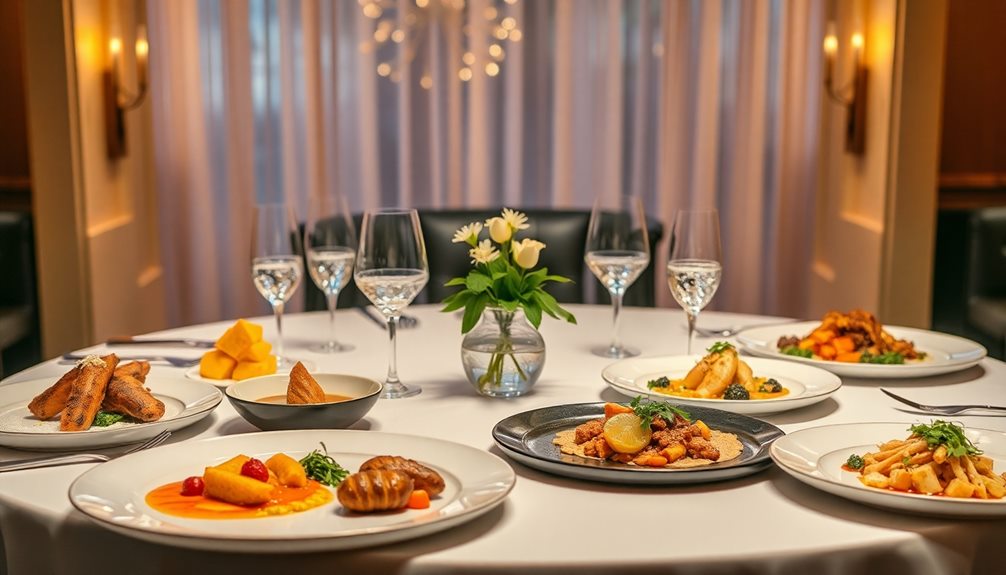
Creating menu descriptions that resonate with your target audience is just the beginning; enhancing the perceived value of each dish is what truly captivates diners. You can achieve this by incorporating descriptive adjectives that highlight preparation methods, like "slow-cooked" or "pan-seared." For instance, a dish featuring locally sourced ingredients can draw from the best restaurants in Gatlinburg to make it even more appealing. These terms not only create anticipation but also set your offerings apart, boosting their perceived value.
Utilizing storytelling elements can forge emotional connections with your diners, making them more likely to see your dishes as worth the price. Share the journey of your ingredients, emphasizing unique sourcing and local farms. When customers learn about the quality ingredients that go into their meals, they often feel more inclined to pay a premium.
Don't underestimate the power of sensory language in your menu descriptions. Words that evoke taste, texture, and aroma can stimulate appetite appeal and enhance perceptions of quality, leading to increased sales.
Pairing your descriptions with enticing food photography can further elevate this effect. Together, these strategies transform simple menu descriptions into compelling narratives that not only attract diners but also justify higher check sizes.
Strategies for Continuous Improvement
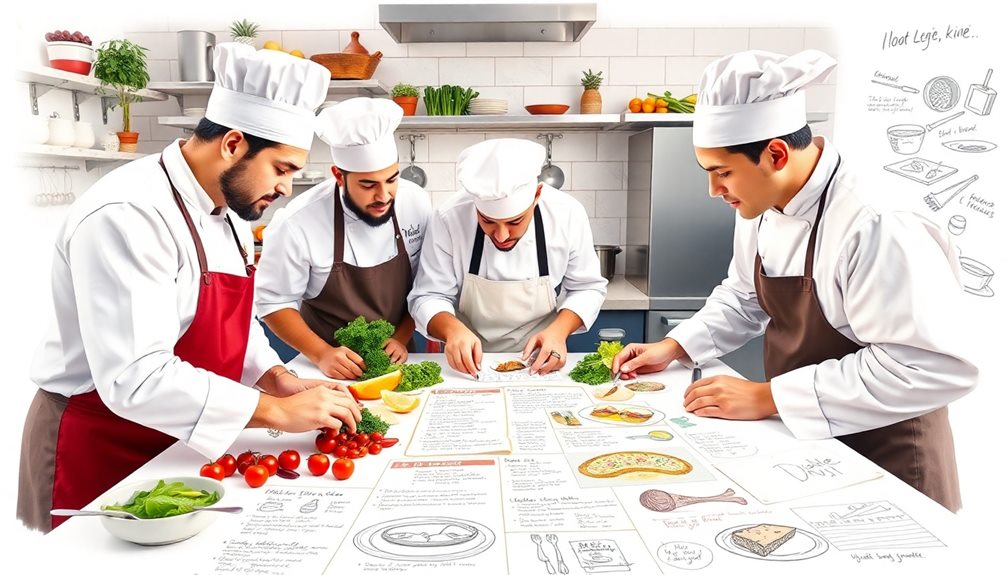
To keep your menu descriptions fresh and engaging, regularly analyze your sales performance to spot top sellers and trends.
Updating your seasonal offerings not only keeps things exciting but also aligns with customer preferences.
Additionally, experimenting with descriptive language can help you find what resonates best with your audience, driving both interest and sales.
Analyze Sales Performance Regularly
Regularly analyzing sales performance is essential for identifying which menu items shine and which ones struggle. By leveraging sales metrics, you can refine menu descriptions to better align with customer expectations.
Begin by focusing on specific areas of improvement:
- A/B Testing: Experiment with different menu item descriptions. Studies show that using engaging, descriptive words can lead to a sales increase of up to 27%.
- Track Popularity: After updating descriptions, monitor the popularity of those menu items. This guarantees your changes resonate with customers.
- Incorporate Feedback: Utilize customer feedback to continually refine descriptions, enhancing overall satisfaction.
Update Seasonal Offerings Frequently
Keeping your menu fresh with seasonal offerings not only excites customers but also encourages repeat visits. By regularly updating your menu descriptions, you can create a sense of urgency and exclusivity, enticing customers to try limited-time dishes. Seasonal offerings appeal to 62% of diners who prefer locally sourced foods, enhancing perceived value and supporting local agriculture.
Here's a quick look at the benefits of updating seasonal offerings:
| Benefit | Impact on Business |
|---|---|
| Boosting Sales | Increases visits during specific seasons |
| Engaging Customers | Creates excitement and anticipation |
| Enhancing Online Visibility | Drives social media engagement |
Analyzing past sales data helps refine your menu updates, ensuring you retain popular dishes while introducing new options based on customer preferences. As 86% of millennials are influenced by food-related content, these updates can markedly enhance your online visibility and attract new customers. So, make it a habit to refresh your seasonal offerings regularly to keep your menu engaging and your customers coming back for more!
Experiment With Descriptive Language
Descriptive language can transform your menu from a simple list into an enchanting narrative that invites diners to indulge. By experimenting with descriptive words, you can create engaging menu descriptions that not only entice but also tell a story behind each dish.
Here are some strategies to enhance your food descriptions:
- Use sensory-rich adjectives like "crispy," "savory," and "zesty" to stimulate appetites.
- Highlight unique aspects, such as locally sourced ingredients or specific cooking methods.
- Incorporate personal anecdotes to forge emotional connections with your customers.
Don't forget to regularly refresh your menu descriptions based on customer feedback and sales performance. This keeps your language relevant and engaging, adapting to changing tastes and trends.
A/B testing can also help you discover which menu adjectives resonate best with your target audience, driving a significant sales increase.
Frequently Asked Questions
How Do You Write a Good Menu Description?
To write a good menu description, focus on vivid language that evokes taste and aroma. Highlight unique ingredients, tell a story, and keep it concise. Your goal's to create an emotional connection with diners.
What Are the 7 Parts of a Menu?
Imagine a symphony; each note plays its part. Your menu's seven parts—title, description, ingredients, portion size, pricing, dietary symbols, and backstory—harmonize to create an unforgettable dining experience that resonates with every guest's palate.
What Is the Description of a Set Menu?
A set menu offers you a curated selection of courses at a fixed price. Each dish showcases unique ingredients and preparation methods, enhancing your dining experience while allowing you to savor seasonal flavors and local authenticity.
How Do You Describe a Meal on a Menu?
When you describe a meal on a menu, use tempting terms that tantalize taste buds. Highlight fresh flavors, unique ingredients, and evoke emotions. Keep it concise yet enchanting, and let your words paint a delicious picture.
Conclusion
In the culinary world, menu descriptions are your secret ingredients, elevating dishes from mere food to tantalizing experiences. By weaving sensory details and understanding your audience, you craft a narrative that dances on the taste buds. Remember, it's not just about what's on the plate; it's about the story you tell. Keep refining your approach, and watch as your menu transforms into a symphony of flavors, enticing diners to savor each bite with enthusiastic anticipation.
